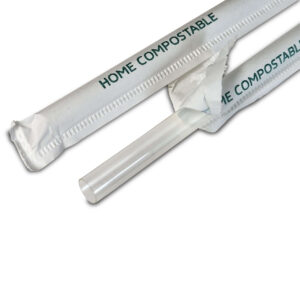The use of biodegradable plastics in restaurants can help to reduce waste, lower the carbon footprint, and contribute to a more sustainable future. Biodegradable plastic straws are an important step towards reducing the negative impact of plastic on the environment. They promote a more environmentally-friendly business model.
There are several benefits to using biodegradable plastics in restaurants, including:
1) Reduced Waste Using Biodegradable Plastics
Biodegradable plastics break down into organic matter within a relatively short period of time. This reduces the amount of waste that ends up in landfills and the negative impact on the environment. This can help restaurants reduce waste in several ways:
 Biodegradable products break down naturally. Unlike traditional petroleum-based plastics, products like biodegradable plastic straws are designed to break down naturally into organic matter. This can happen within a relatively short period of time. This means that they do not accumulate in landfills, reducing the amount of waste produced by the restaurant.
Biodegradable products break down naturally. Unlike traditional petroleum-based plastics, products like biodegradable plastic straws are designed to break down naturally into organic matter. This can happen within a relatively short period of time. This means that they do not accumulate in landfills, reducing the amount of waste produced by the restaurant.
Biodegradable products can be composted. Biodegradable products can be composted along with other organic waste. Doing so creates nutrient-rich soil that can be used in gardening and farming. This not only reduces waste but also helps to create a closed-loop system where restaurant waste is used to create healthy soil; a valuable resource.
Biodegradable products can replace single-use plastics. Biodegradable products, such as biodegradable plastic straws, food-to-go containers, and packaging, can replace single-use plastics that are not biodegradable and often end up in landfills. This can significantly reduce the amount of waste sent into landfills by restaurants.
Biodegradable products can be recycled. Some biodegradable products, such as paper and cardboard, can be recycled along with other recyclable materials. This not only helps reduce waste but also conserves natural resources.
Biodegradable products like KonzaWare Earth biodegradable plastic straws help restaurants to significantly reduce the amount of waste they produce, and send to landfills. This is better for the environment and can save money on waste disposal costs.
2) Lower Carbon Footprint
Biodegradable plastics help restaurants reduce their carbon footprint in a number of ways:
Renewable resources.
Biodegradable plastics are made from renewable resources, such as wood pulp, corn starch, sugarcane, or potato starch. These natural resources absorb carbon dioxide from the atmosphere as they grow, which helps to reduce the carbon footprint of the restaurant.
Reduced greenhouse gas emissions. Biodegradable plastics require less energy to produce compared to traditional petroleum-based plastics. This in turn reduces the greenhouse gas emissions associated with their production.
Reduced landfill emissions. Biodegradable plastics break down naturally into organic matter. This natural breakdown reduces the amount of waste that ends up in landfills. Landfills are a significant source of greenhouse gas emissions, and so by reducing the amount of waste sent to landfills, biodegradable plastics help to lower the carbon footprint of the restaurant.
Closed-loop systems.  Biodegradable plastics can be composted. This creates nutrient-rich soil that can be used in farming or gardening. Many municipal landfills are composting to create healthy soil for their communities, thereby reducing the need for energy-intensive fertilizers and further lowering the carbon footprint of the restaurant.
Biodegradable plastics can be composted. This creates nutrient-rich soil that can be used in farming or gardening. Many municipal landfills are composting to create healthy soil for their communities, thereby reducing the need for energy-intensive fertilizers and further lowering the carbon footprint of the restaurant.
In short, biodegradable plastics help restaurants reduce their carbon footprint by a) using renewable resources that absorb carbon dioxide from the atmosphere while they grow, b) reducing landfill emissions by sending less waste into landfills, and c) creating healthy soil that needs less fertilizer to crop food.
Overall, the use of biodegradable plastics in restaurants can significantly lower the restaurant’s carbon footprint and contribute to a more sustainable future. It is an important step towards reducing the negative impact of plastic on the environment and promoting a more environmentally-friendly business model.
3) Sustainability using Biodegradable Plastics
Using biodegradable plastics aligns with a sustainable and environmentally conscious business model, making it a popular choice for environmentally-conscious consumers.
The use of biodegradable plastics is more sustainable and eco-friendly than traditional petroleum-based plastics for several reasons:
Reduced reliance on fossil fuels. Biodegradable plastics are made from renewable resources, such as corn starch or sugarcane, which are grown rather than extracted from fossil fuels. This reduces the dependence on non-renewable resources and the environmental impact associated with their extraction.
Lower carbon footprint. The production of biodegradable plastics results in fewer greenhouse gas emissions than traditional petroleum-based plastics. This is because the renewable resources used to make biodegradable plastics absorb carbon dioxide from the atmosphere as they grow.
Reduced waste. Biodegradable plastics break down into organic matter within a relatively short period of time, which means they do not accumulate in landfills and contribute to the negative environmental impacts associated with waste. This can reduce the amount of waste produced by the restaurant and reduce the need for waste disposal.
Safe for the environment. Biodegradable plastics do not release harmful chemicals into the environment as they break down, which can reduce the negative environmental impacts associated with traditional petroleum-based plastics.
Closed-loop systems. Biodegradable plastics can be composted, which creates nutrient-rich soil that can be used in gardening and farming. This creates a closed-loop system where waste is used to create a valuable resource, which promotes a more sustainable and eco-friendly business model.
Overall, the use of biodegradable plastics promotes a more sustainable and eco-friendly approach to plastic use. This aligns with the growing concern for environmental issues and the demand for environmentally-conscious products and services.
What Else Can Be Done?
Using local and seasonal ingredients. Restaurants can source their ingredients from local and sustainable producers, reducing the carbon footprint of their ingredients and supporting the local economy.
Implementing composting and recycling programs. Restaurants can implement composting and recycling programs to reduce the amount of waste sent to landfills and reduce their carbon footprint.
Using energy-efficient equipment. Restaurants can invest in energy-efficient equipment, such as LED lighting, Energy Star-certified refrigeration units, and low-flow water systems.
Switching to reusable products. Restaurants can switch from disposable to reusable products, such as reusable plates, utensils, and to-go containers, reducing the amount of waste generated.
Offering plant-based options. Restaurants can offer more plant-based options on their menus, which have a lower carbon footprint and are often more environmentally friendly.
Partnering with sustainable suppliers. Restaurants can partner with sustainable suppliers, such as those that use environmentally-friendly packaging and sustainable farming practices.
By implementing these sustainability practices, restaurants can significantly reduce their environmental impact and contribute to a more sustainable future.
It is important to note that while biodegradable plastics are a step in the right direction, they are not a complete solution. In order for biodegradable plastics to break down, they need to be exposed to certain environmental conditions, such as sunlight and heat. If these conditions are not present, biodegradable plastics may not break down as quickly as expected and can persist in the environment for a long time.
Are Food Digesters Good for Restaurants?
Food digesters can be a good option for restaurants to manage their food waste sustainably. Here are some reasons why:
Cost savings. By reducing the amount of waste sent to landfills, restaurants can save on disposal costs, which can be significant for businesses that produce a lot of food waste.
Improved hygiene. Keeping food waste on-site for an extended period can attract pests and create unpleasant odors, which can affect the hygiene of the restaurant. By using a food digester, food waste can be disposed of quickly and hygienically, reducing the risk of contamination.
Reduced environmental impact. As mentioned earlier, using a food digester to compost food waste can reduce methane emissions from landfills, which is a significant contributor to climate change. Additionally, by reducing the amount of waste sent to landfills, restaurants can help reduce the environmental impact of these facilities.
Marketing and branding opportunities.
Adopting sustainable practices can be a positive differentiator for businesses, and using a food digester to manage food waste can be a selling point for environmentally conscious customers.
However, it is important to note that the sustainability and practicality of using a food digester in a restaurant setting will depend on several factors, including the size of the establishment, the type and quantity of food waste generated, and the availability of space and resources to operate the digester. Therefore, it is important for restaurants to carefully evaluate their options before deciding whether a food digester is a viable solution for their food waste management needs.
In summary, using biodegradable plastics in restaurants can help to reduce waste, lower the carbon footprint, and contribute to a more sustainable future. It is an important step towards reducing the negative impact of plastic on the environment and promoting a more environmentally-friendly business model.


